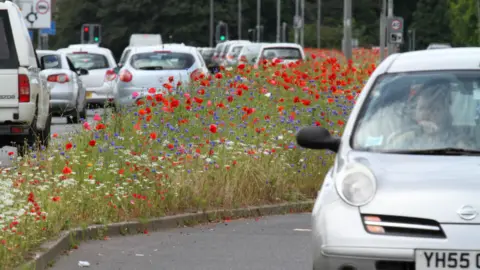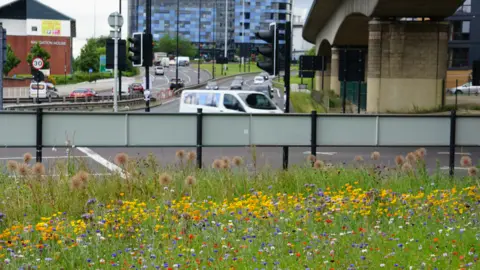Why are England's roadsides blooming?
 Pictorial Meadows
Pictorial MeadowsA long-running campaign encouraging councils to let neatly-mown grass verges become mini meadows where wildflowers and wildlife can flourish appears to be building up a head of steam.
Since 2013, Plantlife has been telling authorities the move could help them save money and boost their green credentials.
Several have taken the message on board. An eight-mile "river of flowers" alongside a major route in Rotherham was widely praised on social media recently and roadside meadows have also popped up in Nottinghamshire, Derbyshire, Birmingham, Newcastle and Sheffield.
So are we likely to see more from the "meadow movement" in the future?
 Kay Dinsdale
Kay Dinsdale
Who's behind the campaign?
Plantlife has been banging the drum for wilder roadside verges since 2013.
The group said the UK had lost 97% of its wildflower meadows in less than a century - with roadside verges particularly hard hit.
It said safety and access considerations along with a desire for "neatness" and the logistics of litter-picking had resulted in authorities adopting an overzealous approach to keeping verges short.
Plantlife said a "cut less, cut later" approach by councils and highways authorities could significantly improve the health of the UK's verges.
It said: "We want flowers to be allowed to flower so pollinators can work their magic and seeds can ripen and fall to the ground. In this way, the floral display will become better and better every year."
 Pictorial Meadow
Pictorial MeadowSo councils are jumping on board?
Some certainly have. Rotherham Borough Council has been ditching the mower and planting wildflower seeds on a stretch between the town centre, Catcliffe and Bramley since 2013 to create its "river of flowers".
Last year, Nottinghamshire County Council decided to trial cutting back on grass mowing at a handful of roadside sites.
However, the unusually hot summer conditions left the authority unsure of the benefits and potential long-term savings of the approach so it has decided to pilot it for another year.
What are the potential savings?
Rotherham Borough Council said its efforts had saved an estimated £23,000 a year in mowing costs.
A slightly more modest £150 was the estimated saving made by Nottinghamshire County Council during last year's pilot.
The authority said this was because its mowing teams still needed to visit each of the six locations to trim back sections affecting motorist visibility.

Presumably wildlife groups are loving it?
Nottinghamshire Wildlife Trust said it "very much supports any project that aims to enhance the value of road verges for wildlife".
Senior conservation officer Ben Driver said: "We've regularly received positive feedback about the stretches of road verge where the county council has carried out wildflower seeding, such as the Lowdham Bypass.
"The easiest gains can often be made on country lanes by simply leaving the grass to grow long throughout the summer.
"We accept it is often necessary to maintain a shorter sward near to the road's edge and at junctions, whilst grading to a taller sward near to the hedgerow."
 JR Lamb Photography
JR Lamb PhotographyPam Hunter, head of research at the British Beekeepers' Association, also welcomed the shift towards more fulsome roadside greenery.
She said: "The amount of area covered by verges and also parks and gardens that the local authorities have is enormous and this constant hacking them back all the time really is a great shame because they could provide a tremendous amount of food for such a wide range of beneficial insects."
However, she said authorities needed to put some thought into how they went about letting their verges grow out.
"It does need managing quite carefully. You can't just leave them," Ms Hunter said. "You might get very lucky if you leave a verge and get some lovely plants growing back.
"Some of the verges on the M40 are absolutely beautiful, absolutely covered in cowslips, and now there's a lot of other lovely flowers, but that doesn't always happen.
"So a lot of the time it has to be an active project from the council or authority to actually plant the right kind of flowers, which can be a bit complicated - but it's certainly been very successful in some areas."
 Gareth Fuller
Gareth FullerAre there any road safety concerns?
Common sense dictates it would not be a great idea to let roadside verges develop into meadows at junctions - but are there other concerns?
Martin Tett, environment spokesman at the Local Government Association, said: "It is crucial that verges are cut to ensure roads are safe for all road users and to prevent road drainage damage.
"However, councils recognise that verges are an important habitat for many species of insects and animals and will take this into account where it is safe and practical to do so."
You may also be interested in:
 Pictorial Meadows
Pictorial MeadowsHighways England said it had a "comprehensive" biodiversity plan that aimed to preserve visibility at junctions and bends, as well as providing a safe area for pedestrians when there is no pavement.
A spokesperson said: "We are committed to improving the biodiversity performance of England's motorways and major A-roads and manage around 30,000 hectares of green space across the country.
"We manage vegetation across our network in a number of ways, but all with the aim of maintaining road safety while also protecting wildlife and take great care in maintaining their habitats."
 Pictorial Meadows
Pictorial MeadowsWhy is this happening now?
Franziska Schrodt, an ecosystems expert at the University of Nottingham, said it was no surprise roadside meadows were becoming a more frequent sight.
She said: "More people are now aware of environmental issues, including pollution and loss of biodiversity which also lead to an acceptance of a messier urban aesthetic.
"Indeed, whilst some continue to view unmowed road verges as untidy, the majority of drivers find them visually pleasing and roadside verge meadows have been shown to reduce driver stress significantly.
"Local councils are responding to these changes in public opinion whilst also considering human resources and economic sustainability, as well as roadside safety.
"From a scientific viewpoint, we now know much more about the importance of roadside vegetation for biodiversity and other critical services to humanity such as regulating pollution, maintaining soil structure and health, reducing flood risk... than even five years ago."
 Pictorial Meadows
Pictorial MeadowsSo will we see more roadside meadows in the future?
Plantlife hopes so. It said: "A few roadside nature reserves is not enough. We want to transform the entire network.
"There are nearly 500,000 km of rural road verge in the UK. This is equal to half of our remaining flower-rich grasslands and meadows. Their potential is enormous."
Can I grow my own urban meadow?
Quite possibly. Peter Thain, from Cheltenham, recently ripped up his front garden and sowed wildflower seeds to create his own mini-meadow.
He said his neighbours thought he was "nuts" but he was really pleased with how it turned out.
 Peter Thain
Peter Thain
Follow BBC East Midlands on Facebook, Twitter, or Instagram. Send your story ideas to [email protected].
